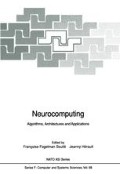Abstract
Whereas artificial neural networks (ANN) provide a powerful scheme for evaluation of multiple simultaneous constraints and inferences, it is not that evident how a given problem, i.e. a conceptual structure, can be mapped on a low-level structure within plausible resource requirements. This is also true in optical character recognition.
We can only do what is possible and proceed from there toward what is desirable.
David Marr
Access this chapter
Tax calculation will be finalised at checkout
Purchases are for personal use only
Preview
Unable to display preview. Download preview PDF.
References
Ackley, D., G. Hinton, and T. Sejnowski (1985). “A learning algorithm for Boltzmann machines,” Cognitive Science , 9, 147–169.
Alpaydin, E. (1988). “Grow-and-learn network,” EPFL-LAMI, Internal note, September 1988.
Alpaydin, E. and P. Marchal (in press). “Snark, a neural optical reader,” to appear in Proc. of Connectionism in Perspective, Zurich, Switzerland October 1988.
Anderson, J., J. Silverstein, S. Ritz, and R. Jones (1977). “Distinctive features, categorical perception, and probability learning: some applications of a neural model,” Psychological Review , 84, 413–451.
Fukushima, K. (1988). “Neocognitron: a hierarchical network capable of visual pattern recognition,” Neural Networks, 1, 119–130.
Grossberg, S. (1988). “Nonlinear neural networks: principles, mechanisms, and architectures,” Neural Networks, 1, 17–62.
Hofstadter, D. (1985). Metamagical themas, New York: Basic books.
Kohonen, T. (1984). Self-organization and associtative memory, Berlin: Springer.
Marr, D. (1982). Vision, San Francisco: Freeman.
Author information
Authors and Affiliations
Editor information
Editors and Affiliations
Rights and permissions
Copyright information
© 1990 Springer-Verlag Berlin Heidelberg
About this paper
Cite this paper
Alpaydin, E. (1990). What is a feature, that it may define a character, and a character, that it may be defined by a feature ?. In: Soulié, F.F., Hérault, J. (eds) Neurocomputing. NATO ASI Series, vol 68. Springer, Berlin, Heidelberg. https://doi.org/10.1007/978-3-642-76153-9_38
Download citation
DOI: https://doi.org/10.1007/978-3-642-76153-9_38
Publisher Name: Springer, Berlin, Heidelberg
Print ISBN: 978-3-642-76155-3
Online ISBN: 978-3-642-76153-9
eBook Packages: Springer Book Archive

